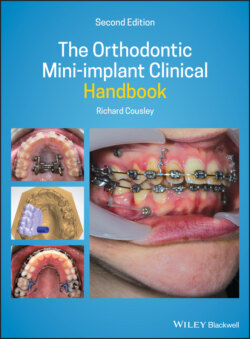Читать книгу The Orthodontic Mini-implant Clinical Handbook - Richard Cousley - Страница 20
1.7 Benefits and Potential Mini‐implant Complications
ОглавлениеMini‐implants have been shown to provide maximum anchorage along with the following benefits.
No need for additional patient compliance (over and above the compliance required for fixed appliance treatment).
Flexible timing for anchorage control, such that mini‐implant anchorage may be ‘switched’ on and off at virtually any stage in treatment. This differs from conventional options where the anchorage, such as headgear, needs to be applied at the outset and is very difficult to add later in treatment.Figure 1.2 (a) Direct anchorage where this grey elastomeric attachment provides traction from the mini‐implant head to a powerarm on the fixed appliance for en masse retraction of the anterior teeth. (b) The maxillary mini‐implant provides indirect anchorage for molar protraction in this hypodontia case. Horizontal traction is applied, using elastomeric chain connected to a vertical auxiliary wire via a ligature wire. The auxiliary wire is joined to both the main archwire, using a cross‐tube attachment, and the mini‐implant head (where its position is secured by composite resin). (c) Indirect anchorage of the upper incisors during unilateral molar protraction, using an elastomeric chain on the fixed appliance. This involves a 0.019 × 0.025 stainless steel auxiliary wire from the midpalatal mini‐implant's head to the central incisors' palatal surfaces, secured to both with composite resin.
Greater predictability of both the treatment mechanics and clinical outcomes. For example, one can now confidently retract the labial segment without anchorage or torque loss in a controlled manner (as described in Chapter 7).
Reduced treatment time, especially where it's more efficient to move groups of teeth rather than subdivide movements in an attempt to spare anchorage demands. This is exemplified by en masse retraction of the canine and incisor teeth in a single phase, rather than two‐phase retraction of the canines then incisors. A randomised trial showed a four‐month time saving in this respect [15].
3D anchorage control. Traditionally, orthodontists think of anchorage reinforcement in the anteroposterior dimension, with much less emphasis on vertical and transverse anchorage. However, now that it's feasible to control anchorage in all three dimensions, orthodontics can truly aim to correct 3D malocclusion traits.
However, a number of risks and side‐effects have been observed over the years with mini‐implant clinical usage and in the research literature. Fortunately, these are reversible in most clinical situations, but it is important to consider them in an effort to maximise mini‐implant treatment success and to provide informed patient consent. The main risks are described in the following sections.
